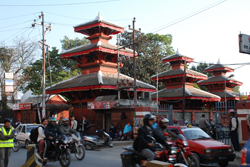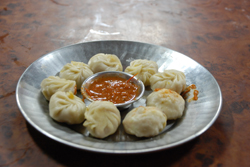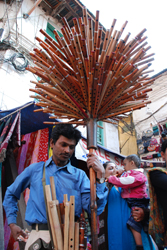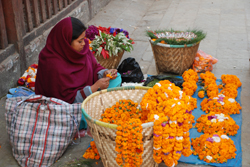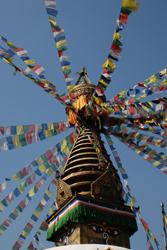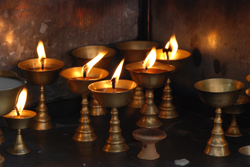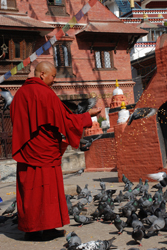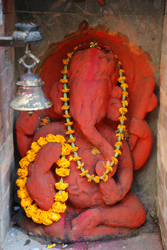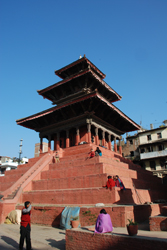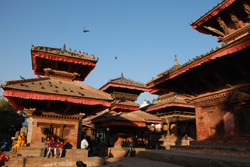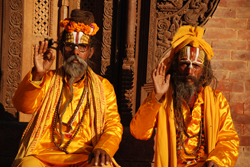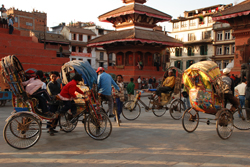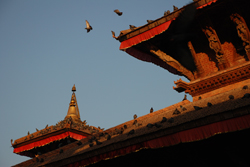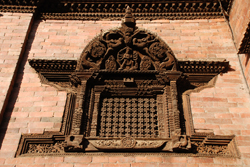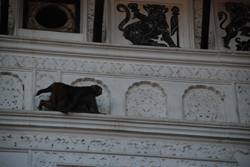Kathmandu: A Feast for the Senses
27 November, 2008, 02:31 am in "Nepal"
Even after a night of no sleep and 2 flights, I couldn't help being excited as we approached Kathmandu. What I thought at first were cloud banks were rows of the snow-capped Himalayan mountains, glistening white. The plane flew parallel to the peaks for an impressive amount of time.
Once landed, we took a taxi to Thamel. It is the tourist ghetto, but with no sleep we wanted to find a hotel as quickly and easily as possible and Thamel is the place for that.
I couldn't help smiling as we progressed through the crazy crowded streets. We passed the Hindu temple of Pashupatinath and lots of people dressed in bright colors. In the distance, green hills rose through the haze.
Thamel feels a bit more like old Berkeley or Haight Ashbury than Nepal with cafes, restaurants, bars blasting rock music and stores of outdoor clothing (almost all knock offs) as well as stores of hand woven clothing that you see more on neo-hippies (or me) than Nepalese. What makes it different from the Bay Area are the number of motorbikes and bicycle rickshaws as well as the Nepalese people, the Tiger Balm and mini chessboard salespeople, and the pollution.
We found an awesome little hole-in the wall restaurant where we had a tasty meal of momos (won tons/raviolis/pelmeni) with vegetable and potato fillings. After wandering a little in the Thamel area, we headed back to the hotel to finally get a good night's sleep.
We found an awesome little hole-in the wall restaurant where we had a tasty meal of momos (won tons/raviolis/pelmeni) with vegetable and potato fillings. After wandering a little in the Thamel area, we headed back to the hotel to finally get a good night's sleep.
The main sight in Kathmandu is Durbar Square. We decided to walk there from Thamel. Once out of Thamel, the streets were still busy but the businesses were geared towards locals. Every block seemed to yield a surprise: a building with beautiful wood carvings, women selling garlands of marigolds on the steps of a shrine, flute sellers with bundles of flutes rising above their heads like palm tree branches.
We almost walked right past a narrow alley leading to a splendid white stupa rising from the middle of a square, its garlands of prayer flags almost transparent from weathering. The eyes of Buddha were painted on it, watching over flocks of pigeons being fed by monks in red robes. It was called the Kathesimbhu Stupa.
On one side of the square, a Buddha statue sat inside a shrine. Back on the main street, we passed shrines to Ganesh covered in red pigment as well as shrines to other Hindu gods.
We took a wrong road and ended up by a huge white tower. Eventually we got directions and turned back to the right road. We came to an impressive Hindu shrine with carved roof supports and a statue of a bull at the foot. The temple was the Jaisi Deval temple devoted to Shiva and the bull was Nandi who is Shiva's primary form of transportation. People sat talking on the steps and around the upper level there were men sleeping in the sun. In the chaotic streets, the multi-stepped temples seem to lift people out of the noise and dirt into the fresher air and within reach of the sun.
A little North of the shrine we came to Durbar square and really couldn't imagine how we missed it. The square (or squares) is huge and filled with Hindu temples, shrines, and a palace or two. It is hard to decide where to look first. The red painted steps rose to multi-tiered roofs of brown wood with ornate carved supports showing gods and consorts, animals and symbols. The roof eves are adorned with red ruffled cloth which ripple in the wind. Some eves are adorned with chimes. The square is filled with locals passing through, tourists staring with wonder, salespeople, ornately dressed sadhus with painted faces and long dreds.
We walked into one ornate building, which turned out to be the home of Kumari, the Living Goddess, a girl who is considered to be the living incarnation of the Goddess Durga. The girl is chosen when she is 3 or 4 after undergoing various tests. She then is confined to the house except during a couple festivals a year, until she reaches puberty and becomes a mortal again.
We continued wandering around the various temples. Then I noticed 2 monkeys running along the wall of a white palace. This turned out to be (appropriately) the Hanuman (monkey god) palace. In front was a small Hanuman statue completely covered with fabric drapes.
One shock for me is the contrast between the imagery of Islamic Iran and Central Asia--repeated patterns, flowers, designs, calligraphy, and almost no figurative representations--to the Hindu imagery with so many physical representations of gods, animals, as well as strange creatures and incarnations of gods with fearsome faces, skulls, and swords, as well as very graphic erotic carvings. It captures the senses: the sounds of the bells, the smell of incense, the visual stimuli, the warmth and scent of candles. The shrines seem dark and mysterious inside. The images are mysterious, frightening and beautiful. Standing on the steps of one of the shrines looking at the other temples and shrines, I was impressed by the beauty and strangeness. Below, the gold clad sadhus left their seat at a picturesque shrine and headed home for the day.
Comments
- Comments
Powered by My Blog 1.69. Copyright 2003-2006 FuzzyMonkey.net.
Created by the scripting wizards at FuzzyMonkey.net..
(Code modified by Rowshan Dowlatabadi)
Created by the scripting wizards at FuzzyMonkey.net..
(Code modified by Rowshan Dowlatabadi)



